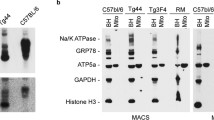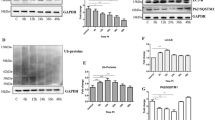Abstract
Prion diseases of humans and animals occur following infection with infectious agents containing PrPSc or in situations in which there is a mutation of the prior protein (PrP) gene. The cellular prion protein (PrPC) is a sialoglycoprotein that is expressed predominantly in neurons. PrPC is converted into a pathogenic form of PrP (PrPSc), which is distinguishable from PrPC by its relative resistance to protease digestion. A number of postulates have been advanced for the function of normal PrP (PrPC), but this issue has not been resolved. To investigate the function(s) of PrPC, we established clonal PC12 cell lines, which have elevated PrPC expression. The results show that there were alterations in dopamine metabolism and in monoamine oxidase (MAO) activity in transfected PC12 cells that overexpress PrPC. There was an increase in concentration of DOPAC, a metabolite of dopamine, and in MAO activity in cells overexpressing PrPC. MAO is involved in oxidative degradation of dopamine (DA). Our data suggest that PrPC plays a role in DA metabolism by regulating MAO activity.
Similar content being viewed by others
References
Andersen J. K., Frim D. M., Isacson O., Beal M. F., and Breakefield X. O. (1994) Elevation of neuronal MAO-B activity in a transgenic mouse model does not increase sensitivity to the neurotoxin 1-methyl-4-phenyl-1,2,3,6-tetrahydropyridine (MPTP). Brain Res. 656, 108–114.
Bassant M. H., Fage D., Dedek J., Court L., and Scatton B. (1984) Monoamine abnormalities in the brain of scrapie-infected rats. Brain Res. 308, 182–185.
Brown D. R. and Besinger A. (1998) Prion protein expression and superoxide dismutase activity. Biochem. J. 334, 423–429.
Büeler H., Fischer M., Lang Y. Bluethmann H., Lipp H. P., DeArmond S. J., et al. (1992) Normal development and behaviour of mice lacking the neuronal cell-surface PrP protein. Nature 356, 577–582.
Collinge J., Whittington M. A., Sidle K. C. L., Smith C. J., Palmer M. S., Clarke A. R., et al. (1994) Prion protein is necessary for normal synaptic function. Nature 370, 295–297.
Cooper J. R., Bloom F. E., and Roth R. H. (1996) Dopamine, in The Biochemical Basis of Neuropharmacology. Oxford University Press, New York, pp. 293–351.
Greene L. A. and Rein G. (1977) Release, storage and uptake of catecholamines by a clonal cell line of nerve growth factor (NGF) responsive pheochromocytoma cells. Brain Res. 129, 247–263.
Kascsak R. J., Rubenstein R., Merz P.A., Tonna-DeMasi M., Fersko R., Carp R. I., et al. (1987) Mouse polyclonal and monoclonal antibody to scrapie-associated fibril proteins. J. Virol. 61, 3688–3693.
Kim J. H., Johansen F. E., Catino J. J., Prywes R., and Kumar C. C. (1994) Suppression of Ras transformation by serum response factor. J. Biol. Chem. 269, 13,740–13,743.
Morier-Teissier E. and Rips R. (1987) Catecholamine metabolite measurements in mouse brain using high-performance liquid chromatography and electrochemical detection: comparison of a one-column technique with a two-column switching technique. Methods Enzymol. 142, 535–549.
Morinan A. and Garratt H. M. (1985) An improved fluorimetric assay for brain monoamine oxidase. J. Phamacol. Methods. 13, 213–223.
Naoi M., Suzuki H., Takahashi T., Shibahara K., and Nagatsu T. (1987) Ganglioside GM1 causes expression of type B monoamine oxidase in a rat clonal pheochromocytoma cell line, PC12h. J. Neurochem. 49, 1602–1605.
Prusiner S. B. (1991) Molecular biology of prion diseases. Science 252, 1515–1522.
Prusiner S. B. (1998) Prions. Proc. Natl. Acad. Sci. USA 95, 13,363–13,383.
Richards J. G., Saura J., Luque J. M. Cesura A. M., Gottowik J., Malherbe P., et al. (1998) Monoamine oxidase: from brain maps to physiology and transgenics to pathophysiology. J. Neural. Transm. Suppl. 52, 173–187.
Rubenstein R., Deng H., Scalici C. L., and Papini M. C. (1991) Alterations in neurotransmitter-related enzyme activity in scrapie-infected PC12 cells. J. Gen. Virol. 72, 1279–1285.
Sakaguchi S., Katamine S., Nishida N., Moriuchi R., Shigematsu K., Sugimoto T., et al. (1996) Loss of cerebellar Purkinje cells in aged mice homozygous for a disrupted PrP gene. Nature 380, 528–531.
Salès N., Rodolfo K., Hässig R., Faucheux B., Giamberardino L. D., and Moya K. L. (1998) Cellular prion protein localization in rodent and primate brain. Eur. J. Neurosci. 10, 2464–2471.
Sourkes T. L. (1972) Influence of specific nutrients on catecholamine synthesis and metabolism. Pharmacol. Rev. 24, 349–359.
Stahl N., Borchelt D. R., Hsiao K., and Prusiner S. B. (1987) Scrapie prion protein contains a phosphatidylinositol glycolipid. Cell 51, 229–240.
Wei Q., Jurma O. P., and Andersen J. K. (1997) Increased expression of monoamine oxidase-B results in enhanced neurite degeneration in methamphetamine-treated PC12 cells. J. Neurosci. Res. 50, 618–626.
Westaway D., DeArmond S. J., Cayetano-Canias. J., Groth D., Foster D., Yang S. L., et al. (1994) Degeneration of skeletal muscle, peripheral nerves, and the central nervous system in transgenic mice over-expressing wild-type prion proteins. Cell 76, 117–129.
Yun S. W., Choi E. K., Ju W. K., Ahn M. S., Carp R. I., Wisniewski H. M., et al. (1998) Extensive degeneration of catecholaminergic neurons to scrapie agent 87V in the brains of IM mice. Mol. Chem. Neuropathol. 34, 121–132.
Author information
Authors and Affiliations
Rights and permissions
About this article
Cite this article
Lee, HG., Park, SJ., Choi, EK. et al. Increased expression of prion protein is associated with changes in dopamine metabolism and MAO activity in PC12 cells. J Mol Neurosci 13, 121–126 (1999). https://doi.org/10.1385/JMN:13:1-2:121
Issue Date:
DOI: https://doi.org/10.1385/JMN:13:1-2:121




